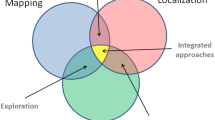Abstract
Today, robotics has experienced a very interesting technological revolution, given the diversity of applications that use autonomous robots in several areas, such as mining exploration. However, prediction with great precision of robot localizations remains a research subject that is always in continuous improvement. In this context, our study consists of a robot, which can move within an area of 15 tiles. It is equipped with a sensing system, which detects obstacles in four directions: north, south, east, and west. The sensors have an error rate of e = 25%. The first step of this study is to model our system by Hidden Markov Model to predict the Robot localization states using the comparison between the Filtering estimation method with Evidence and the Prediction Filtering without Evidence.
Access this chapter
Tax calculation will be finalised at checkout
Purchases are for personal use only
Similar content being viewed by others
References
Boudnaya, J., Haytoumi, A., Eddayer, O., Mkhida, A.: Prediction of robot localization states using hidden Markov models. In: Masrour, T., Cherrafi, A., El Hassani, I. (eds.) A2IA 2020. AISC, vol. 1193, pp. 253–262. Springer, Cham (2021). https://doi.org/10.1007/978-3-030-51186-9_18
Baltzakis, H., Trahanas, P.: Hybrid mobile robot localization using switching state-space models. In: Proceedings of the 2002 IEEE International Conference on Robotics & Automation, Washington, pp. 366–373 (2002)
Aycard, O., Laroche, P., Charpillet, F.: Mobile robot localization in dynamic environments using places recognition. In: Proceedings of the 1998 IEEE International Conference on Robotics & Automation, Belgium, pp. 3135–3140 (1998)
Oishi, S., Inoue, Y., Miura, J., Tanaka, S.: SeqSLAM++: view-based robot localization and navigation. Robot. Auton. Syst. 112, 13–21 (2019)
Colle, E., Galerne, S.: A robust set approach for mobile robot localization in ambient environment. Auton. Robot. 43(3), 557–573 (2019). https://doi.org/10.1007/s10514-018-9727-4.hal-01758277
Merriaux, P., Dupuis, Y., Boutteau, R., Vasseur, P., Savatier, X.: Robust robot localization in a complex oil and gas industrial environment. J. Field Robot. 35(2), 213–230 (2018). hal-01535781
Pagetti, C.: Module de sûreté de fonctionnement. Chaine de Markov, pp. 34–41. ENSEEIHT 3ème TR-Option SE (2012)
Hafez, O.A., Arana, G.D., Joerger, M., Spenko, M.: Quantifying robot localization safety: a new integrity monitoring method for fixed-lag smoothing. In: IEEE International Conference on Robotics and Automation (ICRA) (2020)
Atiya, S., Hager, G.: Real-time vision-based robot localization. Technical report, University of Pennsylvania (1990)
Colle, E., Galerne, S.: Amulti hypothesis set approach form obile robot localization using heterogeneous measurements provided by the internet of things. Robot. Auton. Syst. 96, 102–113 (2017). https://doi.org/10.1016/j.robot.2017.05.016.hal-01621289
Eddy, S.R.: Hidden Markov models. Sequences Topol.: Curr. Opin. Struct. Biol. 6, 361–365 (1996)
Practical tutorial- Robot localization using Hidden Markov Models. https://dtransposed.github.io/blog/Robot-Localization. Accessed 20 Jan 2020
Acknowledgments
In the term of this paper, we thank the Laboratory of Mechanic, Mechatronics and Control (L2MC) of the ENSAM MEKNES. We do not forget both our colleagues and experts for the information source. In addition, we thank the steering committee of the International Conference on Advanced Intelligent Systems and Informatics (AISI 2021) for allowing us to communicate our works and results.
Author information
Authors and Affiliations
Editor information
Editors and Affiliations
Rights and permissions
Copyright information
© 2022 The Author(s), under exclusive license to Springer Nature Switzerland AG
About this paper
Cite this paper
Boudnaya, J., Cherrat, M., Gharib, I., Mkhida, A. (2022). Comparison Between Filtering Estimation with Evidence and Prediction Filtering Without Evidence to Predict a Robot Localization States. In: Hassanien, A.E., Snášel, V., Chang, KC., Darwish, A., Gaber, T. (eds) Proceedings of the International Conference on Advanced Intelligent Systems and Informatics 2021. AISI 2021. Lecture Notes on Data Engineering and Communications Technologies, vol 100. Springer, Cham. https://doi.org/10.1007/978-3-030-89701-7_13
Download citation
DOI: https://doi.org/10.1007/978-3-030-89701-7_13
Published:
Publisher Name: Springer, Cham
Print ISBN: 978-3-030-89700-0
Online ISBN: 978-3-030-89701-7
eBook Packages: Intelligent Technologies and RoboticsIntelligent Technologies and Robotics (R0)




